
Commonly known as cuckoo wasps or emerald wasps, the hymenopteran family Chrysididae is a very large cosmopolitan group of parasitoid or kleptoparasitic wasps, often highly sculptured, with brilliant metallic colors created by structural coloration. They are most diverse in desert regions of the world, as they are typically associated with solitary bee and wasp species, which are also most diverse in such areas. Their brood parasitic lifestyle has led to the evolution of fascinating adaptations, including chemical mimicry of host odors by some species.

Pepsis is a genus of spider wasps belonging to the family Pompilidae. Species within this genus are also called tarantula hawks, as they usually hunt tarantulas, similarly to many species in the genus Hemipepsis. These wasps are restricted to the Americas, with the related genus Hemipepsis occurring in both Old and New Worlds.

Larra, also known as mole cricket wasps or mole cricket hunters, is a genus of wasps that prey on various species of mole crickets. They have gained prominence as integrated pest management agents.
Walter Linsenmaier was a Swiss artist and entomologist. He was particularly known for his highly detailed illustrations of animals, plants, and insects which were widely published in magazines and books. He was also one of the 20th century's most important experts on the cuckoo wasp family (Chrysididae) and described over 600 new species and subspecies of these insects. Linsenmaier was awarded an Honorary Doctorate from the University of Bern in 1982 in recognition of his scientific and artistic achievements and the Ernst Jünger Prize for Entomology from the State of Baden-Württemberg in 1992.

Chrysis inaequalis is a species of cuckoo wasps. The species occurs in Central and Southern Europe and in the Near East. The head and the thorax are shiny metallic blue-green, while the abdomen is red. Adults grow up to 5–10 millimetres (0.20–0.39 in) long and can be encountered from late June to mid September, especially flying on sun-exposed walls, on rocks and on dead wood.

Hedychrum rutilans is a species of cuckoo wasps. The species occurs primarily in Austria, Italy, Bulgaria, Greece, France, Poland, Portugal, Spain, Switzerland and in North Africa. The head and thorax are metallic green with red spots, while the abdomen is red. The color is more green and partially golden in the male and more extensively golden-red in the female. The body is somewhat hairy.

Chrysis is a very large genus of cuckoo wasps. It is the largest genus in the family, including over 1,000 species in over 20 subgenera, as speciose as all remaining Chrysididae combined. The generic name is derived from Greek chrysis, "gold vessel, gold-embroidered dress", and pays tribute to the brilliant metallic appearance of wasps in the genus.

Chrysidini is a very large tribe of cuckoo wasps in the subfamily Chrysidinae; this tribe contains more than half of all chrysidid species.
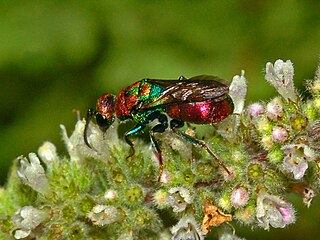
Hedychrum is a large genus of cuckoo wasps. With roughly 150 species, it is the second largest genus in the family; most species are from the Palaearctic, but they can be found in the Oriental, Afrotropical, Nearctic, and Neotropical regions. Their hosts are typically from the subfamily Philanthinae.
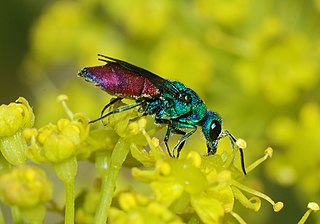
Chrysura is a genus of cuckoo wasps which parasitize megachilid bees. There are 117 species in Chrysura, all but 11 of which are found in the Palaearctic, making it the third largest genus in the family. The genus was described by Dahlbom in 1845, and the type species for the genus is Chrysura austriaca.

Chrysidea is a genus of cuckoo wasps.

Chrysidea pumila is a species of cuckoo wasps belonging to the subfamily Chrysidinae. Some authors consider this species as a synonym of Trichrysis pumilionis Linsenmaier, 1987.

Holopyga fastuosa is a species of cuckoo wasp.
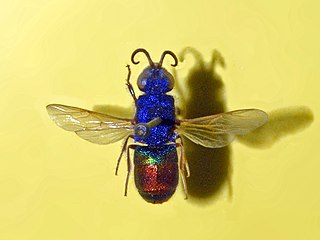
Chrysis comparata is a species of cuckoo wasps.

Parnopes is a genus of cuckoo wasps in the family Chrysididae. The known hosts are in the Crabronidae, subfamily Bembicinae.
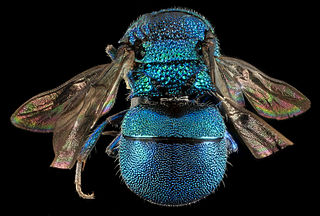
Elampini is a tribe of cuckoo wasps in the family Chrysididae.

Chrysura simplex is a species of cuckoo wasps, insects in the family Chrysididae.
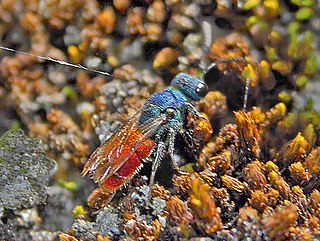
Chrysis ruddii, the ruby-tailed wasp, is a species of cuckoo wasps, an insects in the family Chrysididae.

Omalus is a genus of cuckoo wasps in the family Chrysididae.
Elampus is a genus of insects belonging to the family Chrysididae.

















